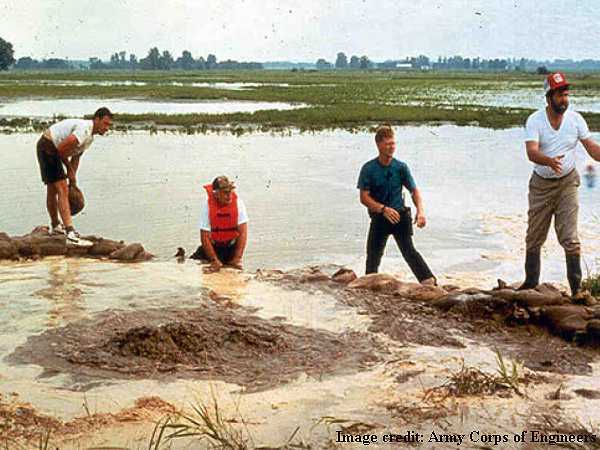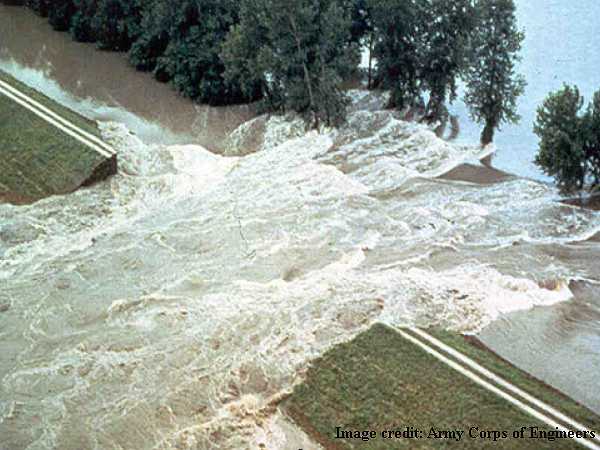LARGE ANIMAL RESCUE SKULL SESSION
|
THE LEVEE IS GIVING WAY!
HOW THE INCIDENT WAS RESOLVED |
|
Background.
In many river delta regions, the lands alongside rivers and sloughs are protected by levees. Many of these levees are ten or more feet in height. Over time, particularly with river flows regulated by dams, the river bottoms have silted to the point that in some places the river bottoms themselves are higher than the surrounding ground. During extreme rains or rapid snow melt, these levees can be taxed with water often reaching the levee tops. The levees are then typically reinforced with plastic tarps and sandbags. When we hear of flooding in these situations we think of water overtopping the levees and eroding channels through them. In reality the most sinister cause of failure, and one rescuers must be cautious about when working near stressed levees, is a boil. A boil starts with a trickle of water that appears in the ground on the "dry land" side of the levee. The water could be coursing through an old animal tunnel, where a rotten root traveled or by some other fracture of the compacted earth. A boil resembles a small volcano of water and boiling sand as the water erodes an even larger underground pathway until the volume of water passing under the levee reaches a point that the levee catastrophically fails.

To prevent a levee failure, a sandbag ring has to be placed completely around the boil, with the sandbags being stacked as high as necessary to prevent water from seeping through and pulling more sediment with it. The wall of the ring has to be thick enough so as not to fail itself once the ring fills with water. However if the ring holds, water should no longer be rapidly passing through the boil and the erosion of the levee should stop. However if the ring cannot be built in time or it fails, a catastrophic levee failure is likely to follow.

The actual incident. The San Joaquin River is within inches of overtopping the levees. About an hour and a half before sunset you have been advised by a nearby island fire department that a significant boil has been discovered near a levee that volunteers are struggling to control. There are several horse ranches within a short distance from the boil. People are evacuating since the only way in or out requires driving past the boil. Assistance is needed to remove up to 50 head of livestock, primarily horses. Roughly a dozen privately owned horse and stock trailers are available on an area callout sheet. They range from straight load trailers to modest sized gooseneck trailers. The trailer owners have varying degrees of horse experience. Few have any actual emergency training or experience. A large animal veterinarian who lives on the island is responding. You have put the County Fairgrounds (approximately 45 minutes away) on stand-by. One of the uninvolved fire departments has a auxiliary communications unit (staffed by trained public safety and amateur radio volunteers) available to you with an approximate ETA of one hour. You have the ability to communicate with the island fire department and with the auxiliary communications unit. Some of the horse owners have secured their animals inside their barns or in nearby corrals. A few horses owned by others have been left out in large pastures. One of the facilities is a breeding facility with mares and foals. You are advised that one of the mares with a foal is functionally blind. By the time the team is mustered to the rendezvous point, you have about an hour left before sunset. You have enough time to load for one trip to the fairgrounds before dark. Skull Session Questions
Group Feedback.
This was an event that required communication, coordination and triage. There were not sufficient resources to remove all horses in the first run and it would be too dangerous to drive into the inundation zone after dark. We mustered all available volunteers and met up with the veterinarian at the road that led to the threatened area. The fairgrounds was notified and a communications unit was dispatched to maintain entry control at the fairgrounds, check in animals and their owner information, keep records, and monitor all relevant radio channels in case any traffic was heard that suggested that the boil containment was failing. We determined that there was a dirt road that led away from the affected area that could be an alternative emergency exit but we were uncertain how well we could travel over it with horse trailers. We responded to horse facilities closest to the boil where we would have to drive past the boil to exit. We identified the numbers of horses "staged" for evacuation and determined the necessary number of horses to be carried per trailer. At the loading point trailers were positioned to facilitate simultaneous loading. We identified the easiest horses to load and experienced loaders assisted getting them into straight load trailers. The remaining horses were divided into compatible groups and were loaded into stock trailers. Records were kept that had the descriptions of the horses, addresses picked up and owners' information. The veterinarian was on-hand in the event a nervous horses had to be twilighted. The veterinarian was not needed. The blind mare and foal were loaded very quietly. The mare followed the foal into the trailer. The communications team was advised as to how many horses were coming in and which horses should be grouped in adjacent stalls due to their coming from the same owners. Since the return trip would be after dark we determined that owners of remaining horses (left out in pastures) would need to bring them to a specific nearby location where it would be safe to load after dark. From arrival at the rendezvous point to all horses loaded and on their way took 23 minutes to evacuate 21 horses. Apparently the owners of the pasture horses either left without them or stayed and decided to risk leaving them in the pastures. Fortunately this particular boil repair held and those pastures didn't flood. In another location in another county the levee failed with disastrous consequences as they apparently did not have an animal evacuation plan.
Go to Skull Session IndexReturn to the Strike Team LRTC Page |
This material is intended for the use of the Technical Large Animal Emergency Rescue (TLAER) Facebook Group. TLAER is a trademark of Technical Large Animal Emergency Rescue. |